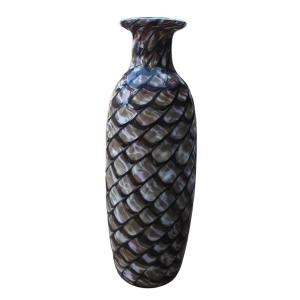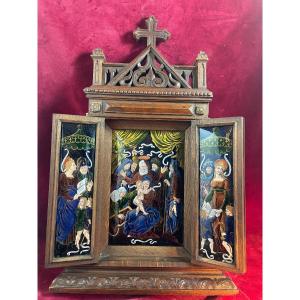Goa, Indo-Portuguese, late 17th century
Carved jackwood with gesso, bole, and polychrome
Height from head to toe: 42 cm, width between the hands 38 cm
Condition: Structurally stable with expected devotional wear, old polychrome layers with some retouching and minor losses.
Provenance: Private European collection
A rare and expressive Indo-Portuguese corpus of Christ, sculpted in wood and retaining substantial areas of its original polychromy. The work exemplifies the dynamic synthesis of European Baroque iconography and South Asian craftsmanship that flourished in the Jesuit workshops of Goa during the late 17th century.
The figure of Christ is shown crucified, head inclined in pathos toward the right shoulder, with finely carved facial features, parted lips, and painted blood streaming from the brow, side, and limbs. The eyes are rendered with a distant upward gaze, evoking the spiritual drama and mystical compassion so typical of the Baroque devotional idiom.
The perizoma (loincloth), tied in a voluminous knot to Christ’s right, is draped in bold, rhythmic folds. Traces of original gilding remain along the knotted belt, a stylistic detail frequently found in high-quality Indo-Portuguese pieces. The anatomical rendering — emaciated torso, prominent knees, and downward-pointed feet — is deeply informed by Iberian Catholic models yet adapted with local sculptural sensibilities.
Close examination reveals the use of dense tropical hardwood, likely jackwood, layered with traditional white gesso, traces of red bole, and natural pigments. The overall surface shows honest devotional wear, minor retouches, and some chipping consistent with age and historical usage.
Context:Carved in Goa, then the epicenter of Portuguese colonial rule and Catholic mission work in Asia, this corpus likely originated in a Jesuit or Franciscan workshop serving both domestic Christian elites and international ecclesiastical patrons. Portable crucifixes of this type were used in private devotion, small chapels, and missionary contexts, and were often exported to Europe, Africa, and the Americas.
Comparable examples can be found in:
The Museu Nacional de Arte Antiga, Lisbon
The Victoria and Albert Museum, London (e.g., IS.11-1970)
The Museu de Arte Sacra, Goa












































 Le Magazine de PROANTIC
Le Magazine de PROANTIC TRÉSORS Magazine
TRÉSORS Magazine Rivista Artiquariato
Rivista Artiquariato